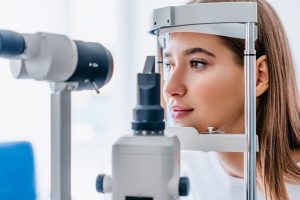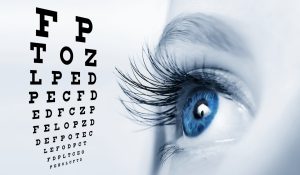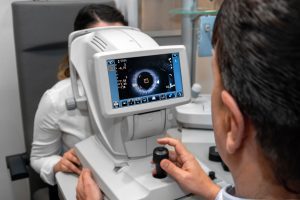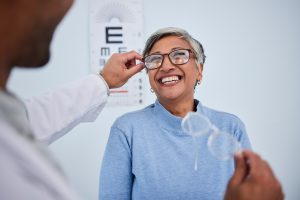Contact Lens Evaluations
A contact lens evaluation is an addition to a comprehensive eye examination. If you’ve already had a comprehensive exam within the last 1-2 years, we can just perform the contact lens evaluation by itself, but if it has been longer, we recommend a comprehensive eye exam first or during the same visit. A contact lens evaluation includes a fitting of contact lenses to determine the best type, size, and fit of contact lenses for an individual’s eyes and visual needs. During the evaluation, we will perform a comprehensive eye examination to assess your vision and eye health and measure the shape and curvature of your cornea to determine the appropriate size and type of contact lenses for you. The evaluation ensures that the contact lenses are safe and effective to use and provides instructions on proper insertion, removal, and care for the lenses.
Preparing for a Contact Lens Evaluation can help ensure a smooth and productive appointment. Here are some tips to help you prepare:
- Bring your current eyeglasses or contact lenses: Your optometrist will want to review your prescription and previous vision history.
- Have your medical history ready: Be prepared to provide details about any previous eye conditions, surgeries, allergies, or medical conditions that could affect your eyes or vision.
- Bring a list of questions: Make a list of any questions or concerns about contact lenses or your eye health, and bring it to the appointment.
- Bring your insurance information: If you have vision insurance, be sure to bring your insurance card and any necessary information.
- Bring your Alberta Health Card: In case any health issues need to be dealt with before a proper evaluation can be done, these can be billed to health care directly.
By following these simple steps, you can help ensure that your contact lens evaluation appointment goes smoothly and that you get the most out of your visit with your optometrist.
Age: 0 - 99
- Contact lens fitting to determine the type and size of lenses that fit your eyes best.
- Trial lenses to test comfort and vision quality.
- Follow-up appointments to evaluate the lenses’ fit and make any necessary adjustments.
- Instructions on how to care for your lenses.
Price: Varies depending on your situation. There are slightly different fees for single vision, astigmatism or multifocal evaluations. Contact our clinic for more information.
West Edmonton Vision Clinic
Visit our vision clinic in central West Edmonton for comprehensive eye exams, contact lens fittings, glasses, and more. Louie Eyecare Centre is dedicated to providing the highest quality optometric services and products to our patients. Our team of experienced optometrists is here to help you with all of your eye care needs. Schedule an appointment today!
Clinic Hours
Monday Closed
Tuesday 9:00-5:00
Wednesday 9:00-5:00
Thursday 9:00-5:00
Friday 9:00-5:00
Saturday 9:00-2:00
Closed Sunday / Holidays
OUR CLIENTS' FEEDBACK
Frequently Asked Questions
Wearing glasses or contacts can indeed affect dry eye symptoms, but the impact varies. Glasses can help shield the eyes from environmental factors that exacerbate dry eye, such as wind or air conditioning. On the other hand, contact lenses can sometimes worsen dry eye symptoms by absorbing tear moisture or by causing irritation. Certain types of contact lenses are designed to be more breathable and retain moisture better, which may be suitable for people with dry eyes. It’s crucial to discuss with an eye care professional to find the most appropriate type of contact lens or glasses. Proper care and hygiene when using contacts, along with regular breaks from screen use, can help minimize dry eye symptoms.
Dry eye syndrome can be both a temporary condition and a chronic disease, depending on its cause and severity. Environmental factors or certain life situations, such as screen use or air travel can cause temporary dry eye. Chronic dry eye, on the other hand, may result from systemic diseases, medication side effects, or age-related changes in tear production. Management and treatment can alleviate symptoms, but chronic dry eye often requires ongoing therapy. It’s important to consult with an eye care professional for an accurate diagnosis and treatment plan. Understanding the underlying cause is key to determining whether dry eye syndrome will be a temporary issue or a chronic condition.
Yes, some specific exercises and therapies can help relieve dry eye symptoms. Blinking exercises, for example, can help improve meibomian gland function and tear film stability. Warm compresses applied to the eyes can also stimulate tear production and release oils from the glands in the eyelids. Gentle eyelid massages can help spread the oils evenly across the eye surface, reducing dryness. Using a humidifier to add moisture to the air and taking regular breaks to rest the eyes during screen time can also be beneficial. Newer technologies such as IPL (Intense Pulsed Light) and RF (Radio Frequency) are also becoming available. Consulting with an eye care professional for personalized advice on exercises and therapies is recommended.
Sleep plays a crucial role in managing dry eye syndrome. Poor sleep can lead to insufficient eye lubrication and worsening dry eye symptoms. During sleep, the eyes rejuvenate and produce the moisture needed for the next day. Good sleep hygiene practices can help ensure the eyes are well-rested and hydrated. It’s also important to avoid sleeping with any airflow directly hitting the face, as this can dry out the eyes. Establishing a regular, restful sleep schedule can significantly improve dry eye symptoms.
Indeed, some medications can exacerbate dry eye symptoms. Diuretics, antihistamines, antidepressants, and some blood pressure medications are known to reduce tear production or alter tear composition. It’s important to review any current medications with a healthcare provider to determine if they could be contributing to dry eye symptoms. Sometimes, alternative medications with fewer dry eye side effects can be prescribed. Always consult with a healthcare professional before making changes to medication regimens. Patients should also stay hydrated and consider using artificial tears if taking medications known to cause dryness.
Yes, it is quite common for dry eye symptoms to worsen in certain weather conditions. Dry, windy, or smoky environments can lead to increased tear evaporation, exacerbating symptoms. Conversely, high humidity can sometimes alleviate dry eye symptoms because the air is more saturated with moisture. Cold weather, especially during winter when indoor heaters are used, can also dry out the eyes. It’s advisable to use humidifiers in such conditions to maintain indoor humidity levels. Wearing wraparound glasses or protective eyewear outdoors can help shield eyes from harsh conditions.




